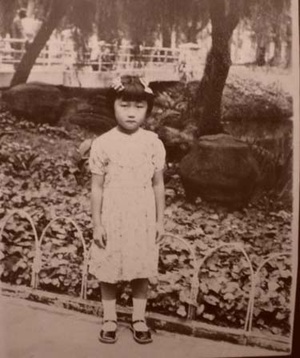The Carnival is the biggest event in Brazil. The Portuguese brought this Pagan tradition to Brazil in the 17th century, and at first it was merely an entertaining recreation for commoners. People had fun in the streets all over town, throwing flower and spraying water at each other.
Today, Brazil is world famous as a “Carnival Country”. However, the carnival has turned into an “Exhibition” nowadays. It seems as though the rich “Escola de samba (School of samba)” and the celebrities are competing to see who can spend the most money.
One of my fondest memories of the carnival as a child was walking around the city of Sao Paulo with my mother.
I have a black and white picture from back then. With a flower-print dress and a ribbon to match on my head, white socks and black shoes with a cute buckle—I was dressed in my Sunday best. If this were a Brazilian child, she probably would have been dressed in a costume and called “adorable” by everyone. Surely, a Brazilian parent would have proudly showed off their child to others. There is nothing that makes a Brazilian parent happier than to hear others give praise to their own children.
Unable to act like myself in front of others, I was too shy to toss around the paper balls and ribbons that my father bought for me. My mother, however, playfully exchanged sprays of perfume from her glass bottle with passersby.
I had always been the quiet type; I was not very good at being joyful around others. So hearing the story about my mother’s first carnival was mesmerizing, and it left a strong impression with me. I’ve always looked up to my mother, so I wrote about this episode in my very first book.
In her 20’s, my mother went to a carnival with my aunt and two other friends. They rode on the cargo bed of a friend’s truck, and took a bumpy ride into the city.
The carnival was held in a warehouse. The attendees danced around in a large circle. At times, the circle became long and thin, as if it were morphing into a giant dragon.
Within that dragon, there was just one Nikkei person—a daughter from a rich family in the area. She was dressed in a beautiful costume and sang and danced so well that she could be mistaken as a Brazilian. She looked like a star.
My mom and her friends were in awe of their first look into a carnival. As they stood still at the entrance, some guys came out of the circle and grabbed her friend Aguri’s hands, and dragged her into the circle.
It happened so suddenly—Aguri-san still had her umbrella in her hands—but just like that, her body was already moving to the beat!
Before they knew it, the other three had joined the circle as well.
When the carnival ended, the four of them looked at each other in their faced and burst into laughter.
Although they didn’t dress up in costumes, their hair and faces were covered in so much sweat and dust, it looked as if they were wearing masks!
© 2011 Laura Honda-Hasegawa





